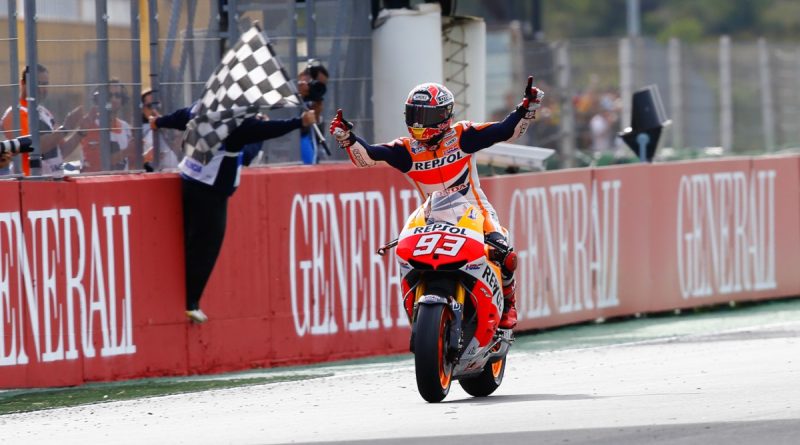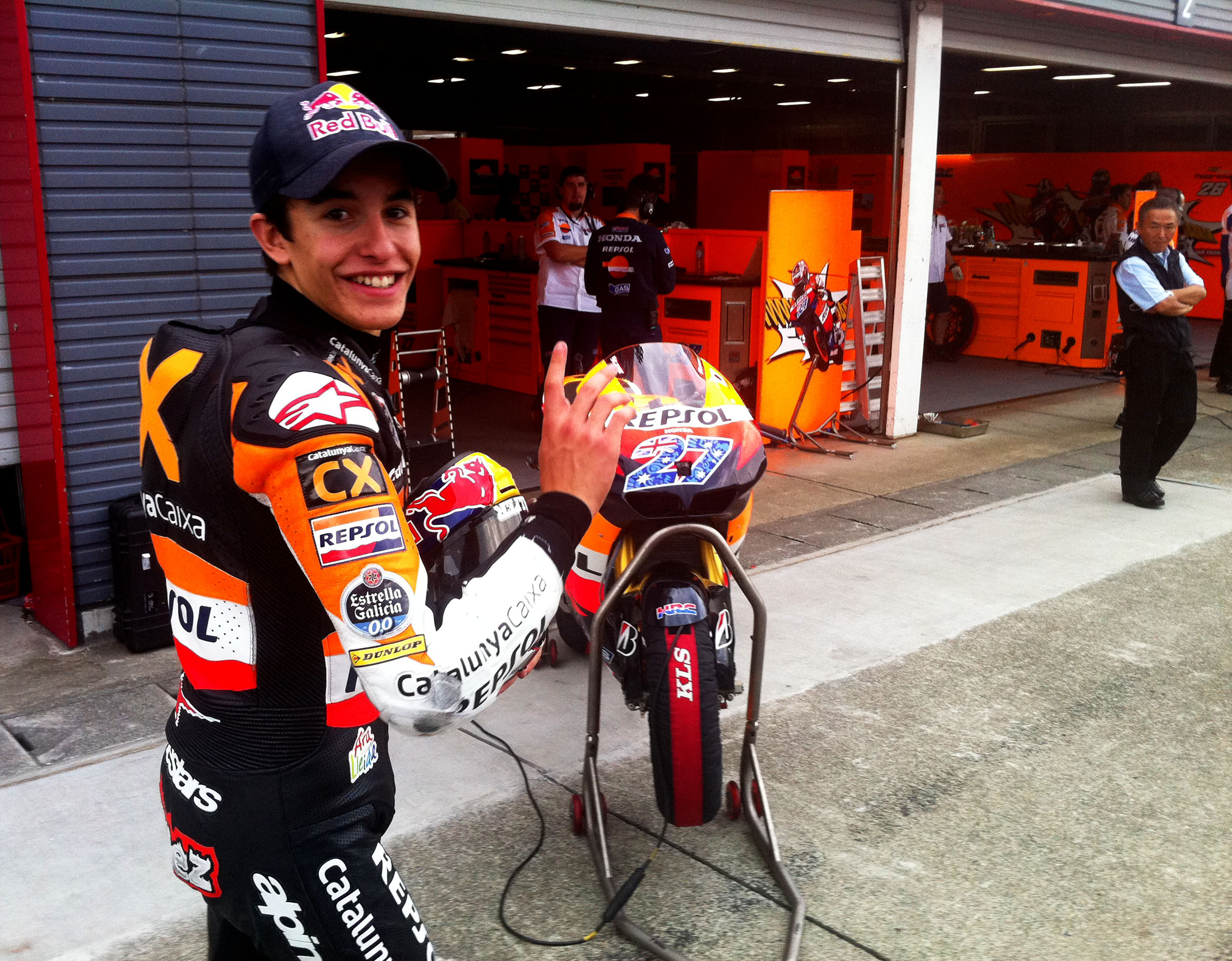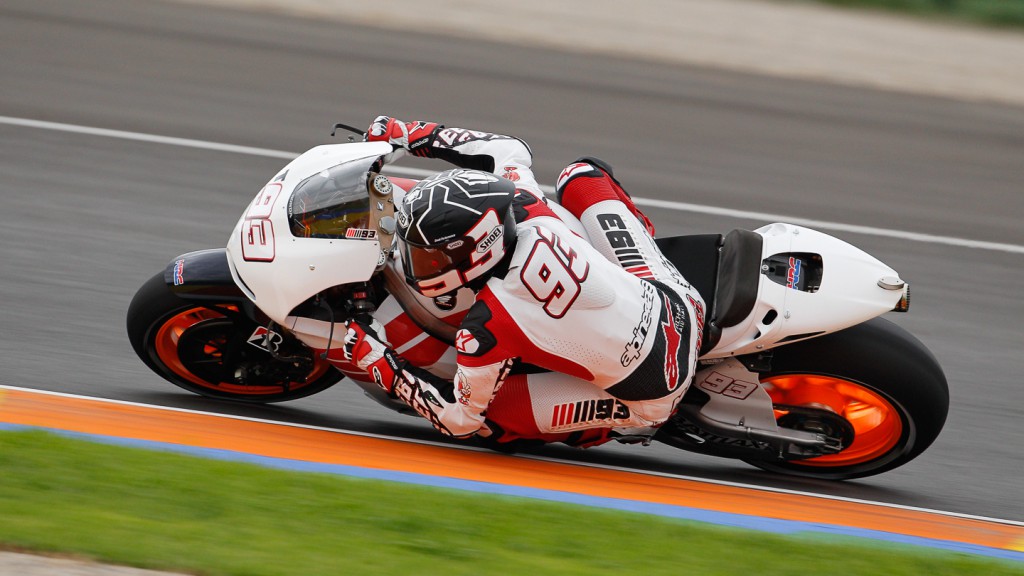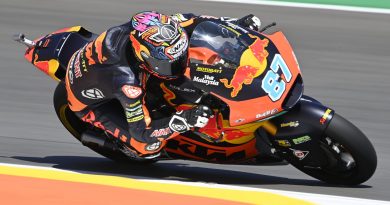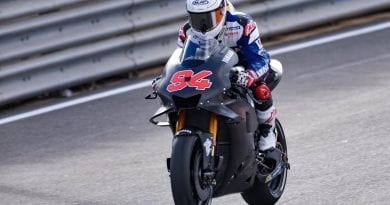Season recap: Marc Marquez’s record breaking rookie season
On 12th July 2012, Marc Marquez was announced as the replacement for the retiring Casey Stoner, little did anyone realise, the future of MotoGP would change forever.
At 19 years old, Marquez was already a 125cc champion, and a Moto2 runner up in 2011 as a rookie and the 2012 Moto2 World Champion on a Suter, the only rider in the middleweight class’ history to win a title on the ‘inferior Suter machinery. His career already at this point was showing some huge signs of promise after becoming the youngest ever Spanish 125cc podium finisher in 2008 at just 15 years and 127 days old, winning the 125cc title in 2010 which includes an Estoril victory from the back of the grid which he would go on to repeat in Valencia 2012, by the end of the 2012 season he was a double World Champion at just 19 years old, everyone was after his signature.
Eventually, it would be Honda who would be victorious in hiring the future prospect in some controversial circumstances, controversy being something Marquez has grown very accustomed to over the years after various Moto2 smashes and crashes before some drama with Valentino Rossi in the years following.
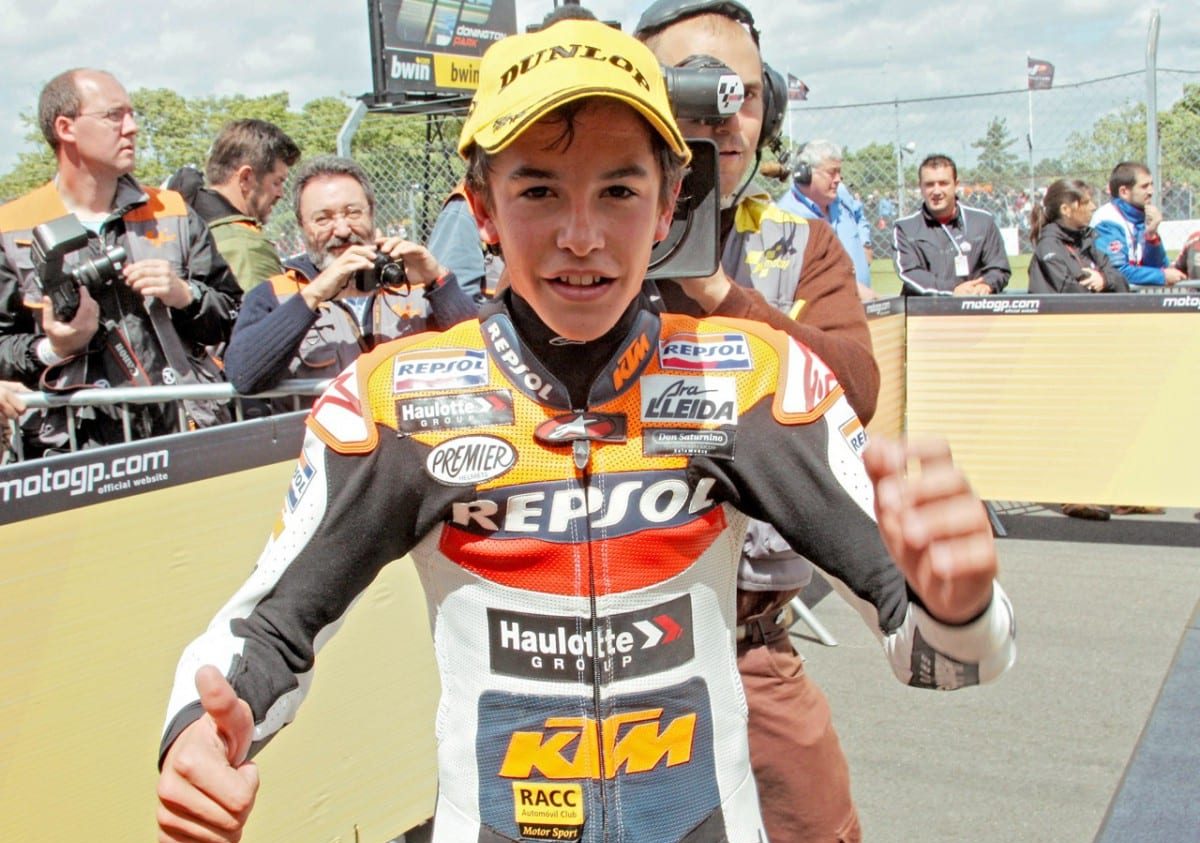
A baby faced Marquez after his first 125cc podium at 15-years-old.
Honda were able to abolish the ‘rookie rule’ which was in place in the premier class to enable Marquez to move straight into the factory Honda team alongside Dani Pedrosa who had also been hired as a rookie, the rule which had only been in place since 2010 and stated that rookies cannot be hired by factory teams, they must first go via the satellite teams in a move by Dorna to help spread talent throughout the class with Ben Spies being forced to ride for the Tech3 team before his factory Yamaha move the year following.
It was controversial as it was a clear sign that Honda had been able to change the rules to their advantage, but let’s be honest here, it’s a pretty dumb rule. If this rule had existed in the 5 years previous and 10 years following 2010 riders such as Dani Pedrosa, Jorge Lorenzo, Maverick Vinales, Alex Rins, Joan Mir, Brad Binder and many more all would’ve had to race for a satellite team before their factory MotoGP move, this rule not being in place enables the riders who deserve factory seats for either, coming from Moto2 as a world champion or showing exemplary talent in their classes previous, to race competitive machinery as they would deserve to. Anyhow these days in 2021 the racing is so close that the difference between a factory bike and a satellite bike could just be something as simple as a paint job as KTM have proven.
Ex-HRC Executive Vice President Shuhei Nakamoto said the following regarding the signing of Marquez: “Marc has already proved how fast he is in 125cc and Moto2, and we believe that giving him the right time to adapt to the new class, he will also be able to show this in MotoGP in the future,” show this Marquez did.
Marc Marquez in 2012 walking past his future garage
Marc Marquez won the Moto2 World Championship in 2012 on a Repsol sponsored Suter MMXII, beating 2021 and 2022 teammate Pol Espargaro by a huge 59 points with nine wins and 14 podiums in 17 races. On Wednesday 14th November 2012, Marc Marquez got his first taste of the Repsol Honda RC213V which Casey Stoner had put on the podium in the days prior in his final MotoGP race, Marquez completed a total of 28 laps with a best lap time of 1:33.403 in his 27th lap, this time put him in seventh overall, this quick adaptation to the 1000cc beast was a sign of things to come.
Marquez was consistent throughout testing finishing fifth overall at the Jerez test and by the time Qatar rolled around, Marquez had fully adapted to the 1000cc MotoGP machine and was ready to race and he was ready to battle for the win, qualifying in sixth place on the grid, the race hotted up to be a great one. The race was everything Marquez had dreamed of for his MotoGP debut, Marquez beat his teammate Dani Pedrosa and battled with childhood hero Valentino Rossi all race long, taking his first MotoGP podium on his debut in third place, a rider walking into the class like this and instantly taking podiums was incredibly rare, it was clear a star had been born.
The Circuit of the America’s round in Austin, Texas made its debut in the world championship in the following race and Marc Marquez would kickstart a six consecutive pole to win streak at the track in just his second race in the class, he was able to prove that he was already a fully-fledged MotoGP ride putting his Repsol Honda in pole position for the inaugural race at the track. This pole position obviously was not enough for Marquez who knew he had more up his sleeve, the next day he took his first MotoGP race win breaking the record for the youngest ever premier class winner aged 20 years and 63 days old (feel old yet?).
Marquez’s astonishing podium form continued the same way for the rest of the season despite him being a rookie, the eventual champion did not finish off of the podium in every race he finished racking up 16 podiums in 18 races with a DNF at Mugello and a DSQ at Phillip Island. He took second place at Jerez then third at Le Mans, this put him in second place in the standings behind teammate Dani Pedrosa.
Marc Marquez with his Moto2, elbow down style with the special testing livery at the 2012 Valencia test
At race five Marquez would suffer his only DNF of the season as he crashed out of the Mugello race at Turn 7, handing second place in the standings to countryman Jorge Lorenzo in the process, Lorenzo already having a chip on his shoulder against the youngster for the famous last corner move at Jerez at the newly named ‘Jorge Lorenzo corner’ where we saw Marquez force his way past the then-current World Champion to finish in second place.
After his Mugello DNF Marquez sat third overall in the championship behind Lorenzo and leader Pedrosa but he knew there was more in the bag. Marquez came back in style finishing in third at Catalunya then second at Assen behind Valentino Rossi who won his first MotoGP race since leaving Ducati, he was now still third in the standings only 23 points from Dani Pedrosa who led the championship.
His fortunes were all about to change in his favour at the Sachsenring where he had a three-win streak winning in the 125cc and Moto2 classes in 2010, 2011 and 2012, Dani Pedrosa and Jorge Lorenzo both did not start the GermanGP through injury with Pedrosa once again breaking a collar bone and Lorenzo damaging a titanium plate in a monumental hi-side, the plate was holding his collarbone together after his crash in Assen. Marquez capitalised from this with perfection, taking every point on the table in this the chance of a lifetime, leaving Germany with the title lead, a whole 2 points over teammate Pedrosa then Jorge Lorenzo with the duo scoring a 0 for obvious reasons.
This surge of luck and confidence was enough for Marquez to turn everyone’s season upside down, he went from a strong rookie to a fully blown title contender and proceeded to stomp his opponents into the ground winning the next three races in a row after the Sachsenring, becoming the youngest rider to ever win four races in a row in the process. He won back to back races in the USA at COTA then Laguna Seca, a track he has never ridden at famously overtaking Valentino Rossi on the corkscrew, replicating a move Rossi previously did on Casey Stoner in 2008.
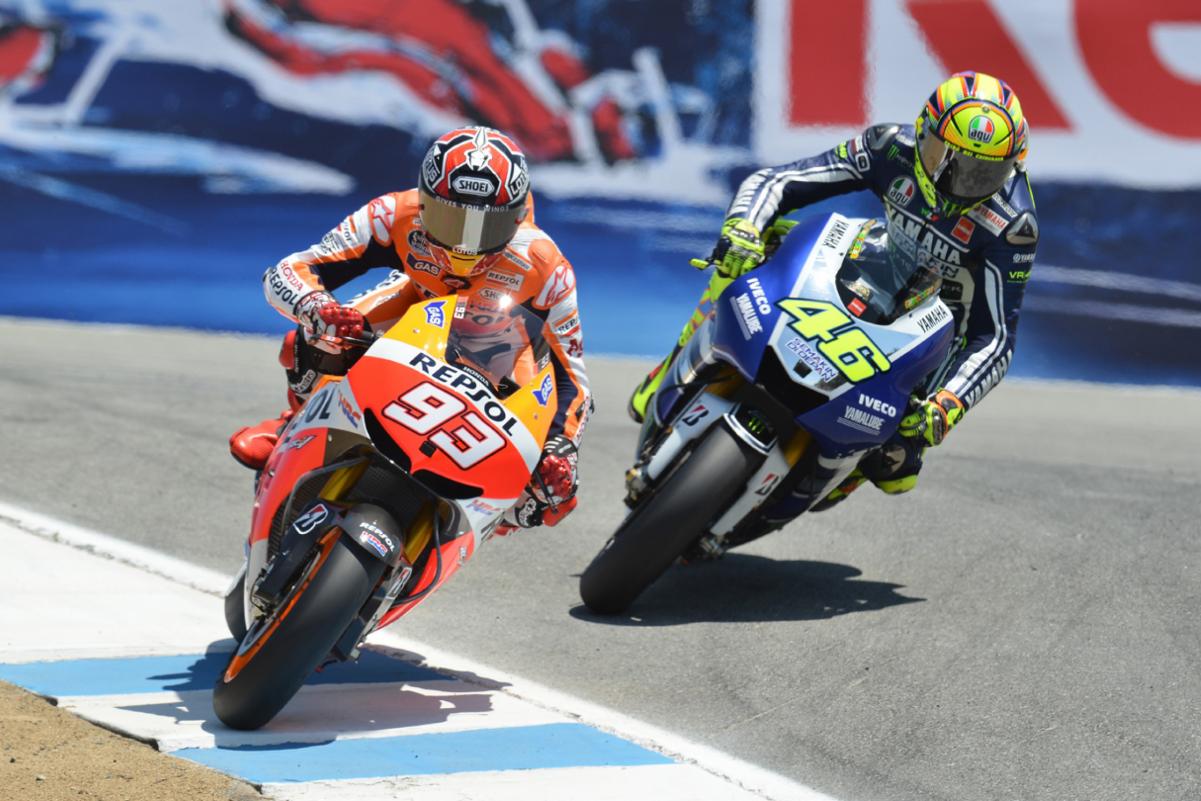
Marquez doing a ‘Rossi’ on Rossi at Laguna Seca
Following the four wins in a row Marquez led the championship by 26 points giving himself a full race buffer if the inevitable was to happen and he would score a zero. Unfortunately for Marquez his winning streak was about to come to an end, he was involved in a hugely dramatic battle with Jorge Lorenzo at Silverstone which went down to the very last few corners with Jorge Lorenzo victorious and Marquez second. At Misano Lorenzo would double up but the consistently consistent Marquez would finish in second place in both races not allowing Lorenzo to gain too much ground on Marquez, Lorenzo would tie with Pedrosa in the championship with the duo 34 points behind Marquez after Misano.
At Aragon the 20-year-old would return once again to the top of the box with a win at before a second place at Malaysia, leaving Sepang with a massive 43 point lead with just three races to go, if he won at Phillip Island and Lorenzo was 3rd, Marquez would be crowned champion.
As we have mentioned previously, Marquez suffered a DSQ at Phillip Island. When MotoGP arrived in Australia to the recently resurfaced track it soon became apparent that the track was now too grippy, the Bridgestone tyres were being eaten up by the surface and there was no way in hell anyone was going to complete a full race distance. This forced Dorna and the race organisers to put a mandatory pit stop after 14 laps during the race, changing over bikes to ensure that the full race distance would be completed on two sets of tyres.
Marquez started the race well leading early on but it was about to end in a disaster, his team miscalculated how many laps had been completed and called Marquez into the pits one lap too late, resulting in a black flag for the championship leader. To make things worse, the win went to Jorge Lorenzo who was able to take a full 25 points out of the 43 point title lead of Marquez, reducing it to a mere 18 points. If the team hadn’t made this fatal error, Marquez would only have had to outscore Jorge Lorenzo by one point at the home of Honda, Motegi, instead he had to outscore Lorenzo by 8 points. If he left Motegi with a 26 point lead he would’ve been crowned champion, this wasn’t to be.
Jorge Lorenzo in pure style took the win at Motegi with Marquez taking second place meaning the championship battle would go down to the last race of the season with just 13 points separating Marquez and Lorenzo, Marquez losing a massive 30 points in two races.
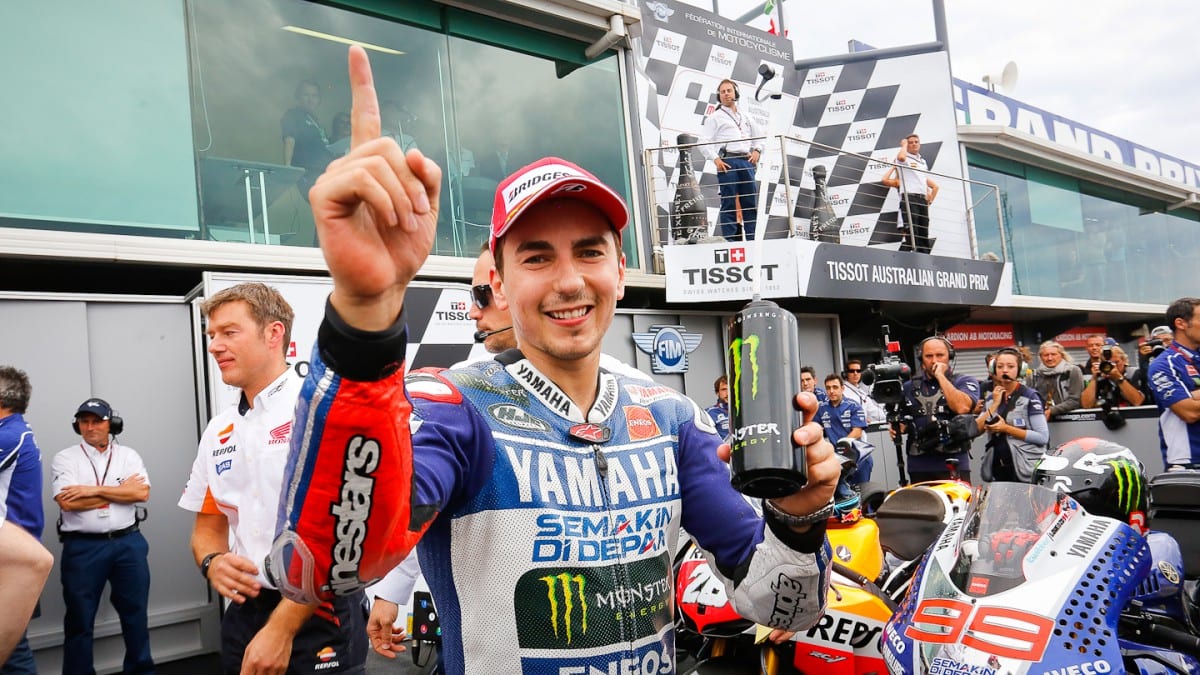
Lorenzo became the first rider aside from Casey Stoner to win at Phillip Island since 2006.
At Valencia Marc Marquez needed to finish in a point-scoring position which would not allow Lorenzo to score more than 13 points, for example, if Lorenzo won the race, Marquez would have to finish in fourth or higher, finishing fourth would seal Marquez’s title by 1 point, anything less and Lorenzo would win, he had more race wins and would have more points. It was a race of high tensions with both Marquez and Lorenzo racing with it all on the line, the day would end with either Lorenzo winning his second title in a row or Marc Marquez winning his first MotoGP title, being the youngest ever champion and the first rookie champion since Kenny Roberts in 1978.
Jorge Lorenzo arrived at the circuit in the form of his life, he had just won two races on the bounce taking 30 points ahead of Marquez, but he knew that even if he won the race it would be out of his hands, Marquez had to finish off the podium for Lorenzo to be crowned the champion, but with Marquez taking a podium in 15 races of 17 it was very unlikely to happen.
Jorge Lorenzo did indeed go on to win the race as expected but it wasn’t enough and he was left to rue Jerez, if Lorenzo wasn’t overtaken at that final corner by Marquez, he would’ve won the championship as those 4 points he lost and Marquez gained were the amount of points which separated them in the standings with Lorenzo taking 330 and Marquez 334. Marc Marquez took the title finishing the race in third place and became the youngest ever champion of the class at 20 years and 266 days old, the rest of the story, well, the history books will tell you that.
Featured images – www.motogp.com
Box Repsol

